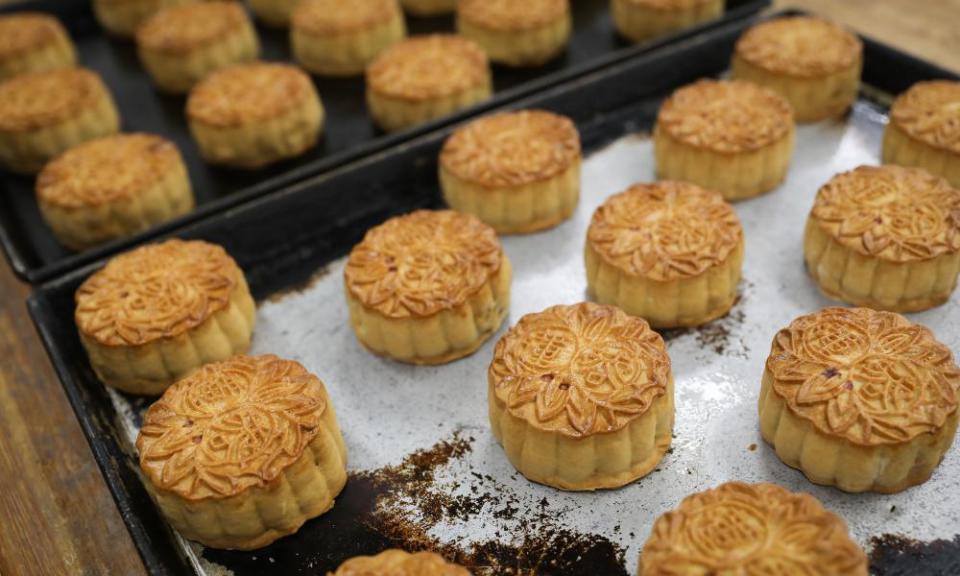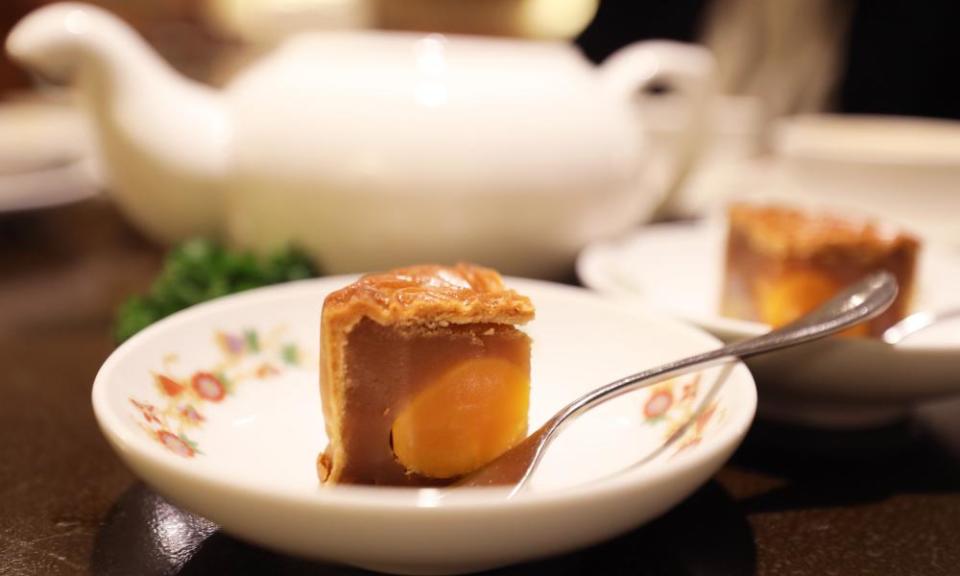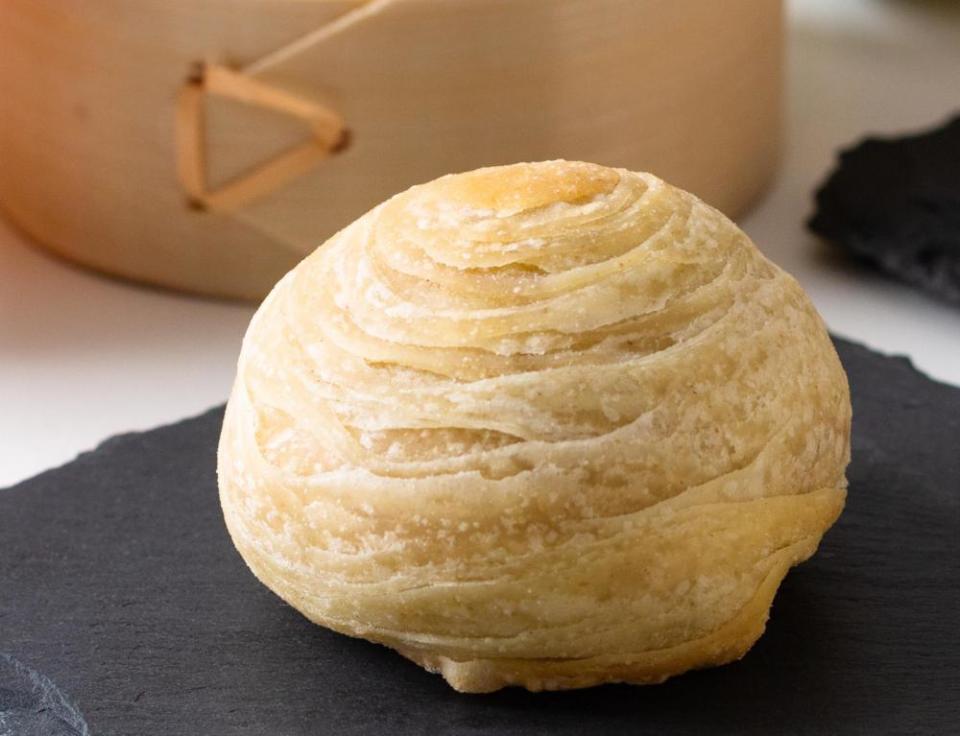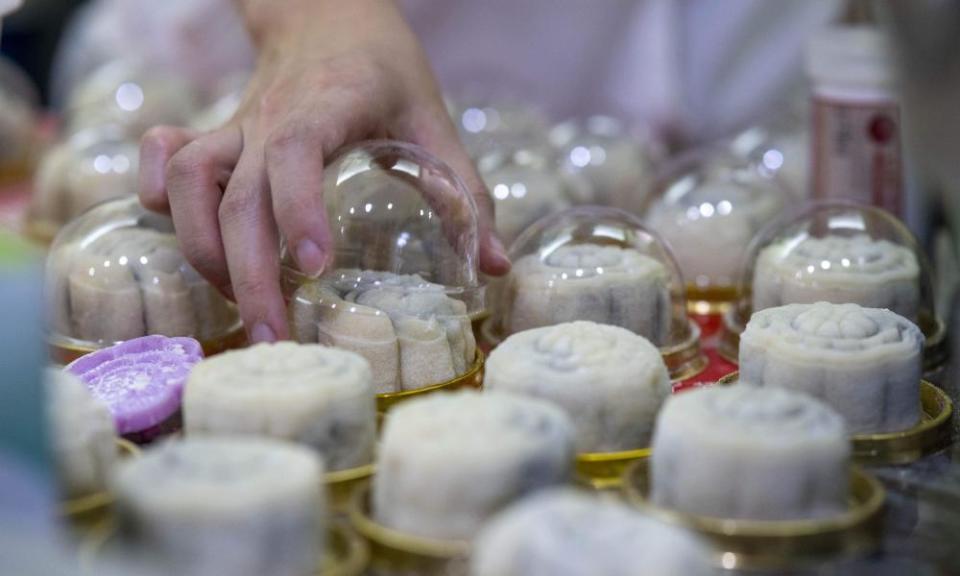Mooncake season: variations on the traditional autumn treat for the Australian spring
It’s mooncake season. You can tell by the mountains of aluminium tins stacked on top of each other in elaborate packaging, boasting anything from one to four salted egg yolks; lotus seed paste; red bean paste; nuts and half-sugar in any Asian grocer.
But what exactly are they and what’s so important about mid-autumn? Even in Australian springtime?
Traditionally, the festival celebrates the autumn harvest that coincides with the moon being at its fullest and brightest. It falls on the 15th day of the eighth month of the Chinese lunisolar calendar, which is 21 September for 2021. In the past, families would gather (mainly to harvest crops), give thanks for a plentiful harvest, and pray for an equally good harvest in the future, for babies to carry on the legacy, and long lives.
Related: Portable, seasonal, wonderful: 10 Yotam Ottolenghi recipes for an Australian spring picnic
These days, due to the introduction of technology and modernised farming practices, the mid-autumn festival is about giving, receiving and eating as many mooncakes as you possibly can.
So what is a mooncake? To explain it in the simplest, possible way, it’s a small, round pastry stuffed with either sweet or savoury filling. There are many different variations of the mooncake, depending on where in Asia you’re from – the only common element being the symbolism of the moon.

The square or lotus-shaped, dense mooncakes with the browned, chewy crust stamped with the name of the bakery you see in most Asian grocers are the Cantonese version. They’re the most recognised mooncake in Australia due to Hong Kong’s financial boom in the 1960s, when they became commercialised and a popular gift item. They’re commonly filled with lotus seed paste and one or two salted yolks.
With the extreme-gifting trend and auspicious nature of all Chinese celebrations, some bakeries stuff up to four salted egg yolks into a single mooncake, because the more moons you have, the more plentiful the bounty for the receiver. You’ll also see red bean paste, mung bean paste, sesame paste and a five-seed mix in some mooncakes, although they’re not as easy to find.
Some bakeries have also introduced half-sugar mooncakes (which are exactly what they sound like) because the biggest compliment any Chinese person can give about a sweet is that it is “not too sweet”. These mooncakes are best shared and enjoyed with a pot of tea.

Photograph: Xinhua/REX/Shutterstock
Suzhou mooncakes are smaller than the Cantonese variety, encased in a flaky lard or butter-based crust, with either lotus seed paste, red bean or savoury pork filling, and can be identified by the sprinkle of black sesame on its top. Traditionally, these mooncakes are cooked in deep, cast-iron pans, but they are now more commonly baked for mass production.

Teochew mooncakes are also called thousand-layer mooncakes due to their appearance. The pastry is made by laminating a water-based and oil-based dough into one another. Fillings of taro, yam, red bean or mung bean paste are added before it is deep-fried.
Fillings differ from region to region because mooncakes are a way to show off the best produce from each area. The climate in the Yunnan province is perfect for curing meat, making Xuanwei ham the star of the sweet-savoury mooncakes from Yunnan. These mooncakes have a crisp exterior and a soft filling of diced Xuanwei ham, lard, honey and sugar.
Sara Tan, the self-taught pastry chef of Buttermilk Pantry tried her hand at making mooncakes at home this year. “Having grown up surrounded by the celebrations of the mid-autumn festival, it holds special memories for me. Due to the lack of international travel, I wanted to take the time to learn the process,” Tan says.
So are they hard to make? It depends how meticulous you want to be, Tan says. If you’re a beginner, you can buy lotus seed paste ( but check the ingredients because sometimes it is blended with bean paste) and pre-cooked salted egg yolks from any Asian grocer. In which case all you have to do is make the pastry, form it around the filling, press it into the mould and bake it.
But if you’d like to control the amount of salt and sugar in each element, you can go as far as making your own salted eggs by separating the yolks from the whites and steaming them; or even soaking, cleaning and cooking your own lotus seeds to make the paste.
After the cooking process, mooncakes require a few days of storage in an airtight container to allow the skins to soften to the correct texture and deepen in colour. “I see mooncakes as a dedication of time and care,” Tan says.

The mid-autumn festival is one of the few traditions that has embraced change over time. “I love how mooncakes have evolved and become vessels for new flavours and pastry concepts,” says Tan.
If you’re a rule-breaking, flavour-chasing, Instagramming youth, you’ll probably find a lot more appeal in contemporary-style mooncakes. Enter the no-bake, snowskin mooncake. The skins are made of cooked glutinous rice flour that can be dyed and flavoured, filled with anything that can be bound by the skin. Common fillings are custard, chocolate, durian, mango and boba milk tea ice-cream, but it can get as wild as your imagination can handle. Jelly-based mooncakes are also a thing, and quite easy to make at home, as long as you have a fridge and a mould – and there are even vegan recipes for them.
At the root of it, the festival is a celebration of a harvest, so as long as you are enjoying a mooncake that is showing off excellent produce, it doesn’t matter if the style you prefer is modern or conventional – just don’t forget the pot of tea.
Although many bakers have already sold out this year, in Australia, you can still order locally made, nationally shipped, mooncakes too.
Ommi’s in Sydney was founded by Omar Hsu, after he worked as a chef in Taiwan and Australia. This year, Ommi’s offers two types of mooncakes: one features salted duck yolk and organic nuts. The other, ‘the Golden Goddess’, has a mung bean filling.
Amour Desserts in Melbourne lives by the not-too-sweet mantra, “just like those found at home” in Malaysia or Singapore, says owner Er Rin Tan. Amour’s ‘Exotic Nyonya Sambal’ mooncake has a homemade filling of sweet-spicy shrimp paste and a salted egg yolk core, all wrapped in soft buttery pastry. Their flagship cake is the Taiwanese 3Q mooncake, made of meat floss, salted egg yolk and red bean paste.
Buttermilk Pantry in Melbourne are also selling mooncakes this year, though you must join their mailing list to find out order details.

 Yahoo News
Yahoo News 
